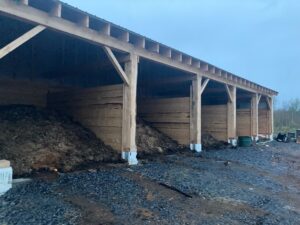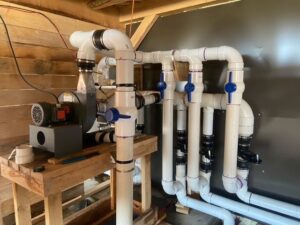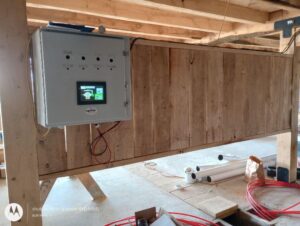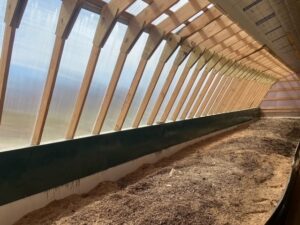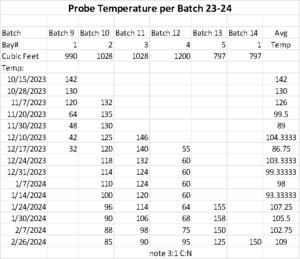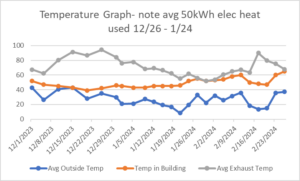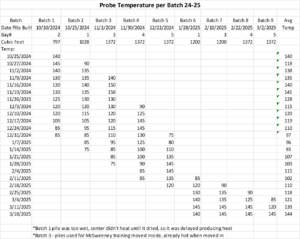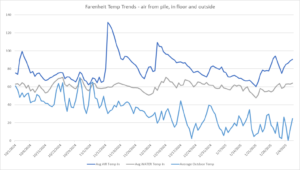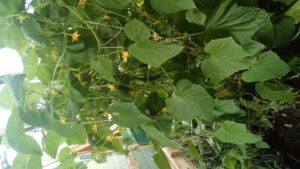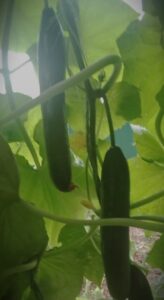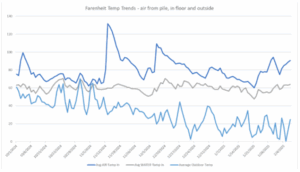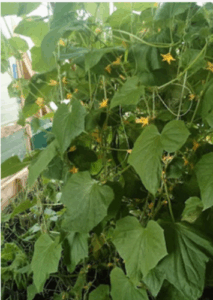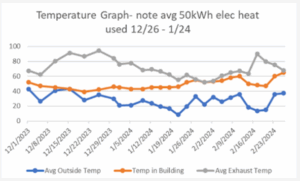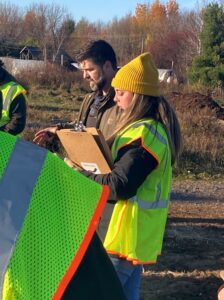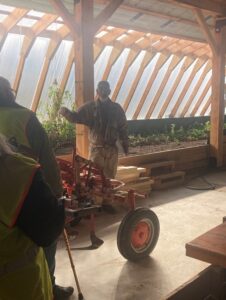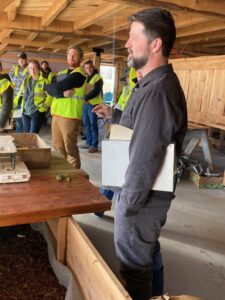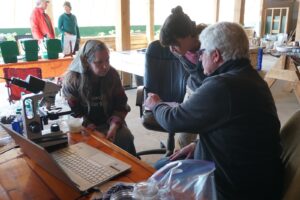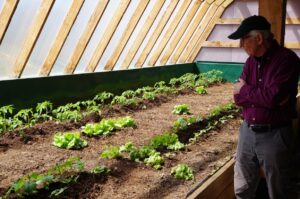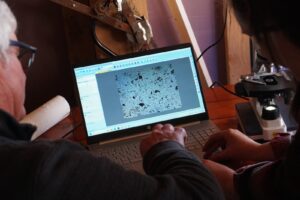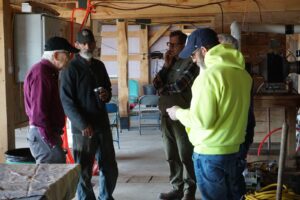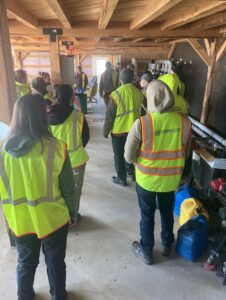Final report for ONE22-427
Project Information
Premise: This project sought to demonstrate that integrated compost and greenhouse production can not only be a synergistically beneficial endeavor, it can increase long-term farm viability by reducing heating and fertilizer costs. The outcomes of the composting process bring the added benefit of processing diverted food waste from landfills, increasing nutrient input to farms, decreasing heating costs, and increasing production leading to an increase in profitability and long term quality of life for farmers. The project goals included:
1. Monitor and capture heat from the exhaust of active reverse aerated compost piles.
2. Demonstrate that captured heat will make it more affordable and sustainable to operate a greenhouse in cold climates.
3. Divert carbon dioxide, ammonia, methane and nitrous oxide in a biofilter before off-gassing into the atmosphere.
4. Record and analyze nutrient data to minimize formation and leakage of CH4 and N2O into the environment.
5. Understand the effects of exhaust nutrients on worms and plants.
6. Experiment with different biofilter mediums, plants and lighting arrangements to determine best practice for producing profitable and nutritious crops.
Basic Methods/Project Description: The Whitten Family Farm (WFF) of Winthrop, NY was awarded grants in 2022 and 2023 to help construct a timber framed barn equipped with a reverse aeration composting system, 5 composting bays and an attached greenhouse. The bays are located on the north side of the building and are 12’ wide and 16’ deep. A perforated HDPE pipe runs through a 12” channel in the center of each pile, drawing air through the cooking compost piles which then passes through a manifold, heat exchanger and blower located inside the adjacent insulated building. Air exiting the active compost piles extracts moisture and nutrients from the decomposing microbial activity.
Some of the moisture is shed from the air as it leaves the channels under the bay, entering the cooler building as well as at the heat exchanger. Condensate traps collect moisture that is released at these points. Heat captured through the heat exchanger is used to heat the building
and onsite water supply. After passing through the heat exchanger, warm, moist nutrient rich air is exhausted into a biofilter located in the
ground on the south side of the building where a 12’ x 60’ greenhouse has been constructed.
The biofilter consists of 4” perforated HDPE pipe running in two continuous loops on either side of the center, covered in 24” of wood chips layered in the bottom of the greenhouse creating an aeration plenum. The plenum is covered by six inches of a soil and compost mixture as well as aragonite, zeolite, soft rock phosphate, biochar and bone char in zones, with the intention of understanding if certain supplements would help to bind excess nutrients. Excessive accumulation of nutrients in growing matrices would be detrimental to crop health and yield, and the air quality within the greenhouse must be safe for occupants. We sought to not just minimize formation and leakage of CH4 and N2O into the environment but also to understand how to manage exhaust through a biofilter to positively affect nutrient availability and temperature for worms and plants.
The greenhouse atmosphere was monitored for CO2 to optimize plant growth and control ventilation to ensure workplace health and safety. Worms (Eiseniia foetida) were introduced to help determine areas of excess nutrient buildup, assuming they would migrate away from nutrient concentrations. Crops grown included cucumbers, tomatoes, lettuce, and mixed greens.
The biofilter was designed so heat, moisture and nutrients in the compost exhaust would move evenly throughout the substrate and then dissipate evenly into the upper layers. The biofilter made up the bed of the greenhouse which consisted of a polycarbonate angled wall and roof, creating passive solar heat gain for the building and a space for year-round growing with minimal to non- existent need for offsite heat. Lights were used to provide light during the short-days of winter, adequate to enable growth of crops.
To support project data collection, the reverse aeration composting system included a monitoring package supplied by Agrilab Technologies. It measures and records temperatures, aeration regimes, air flow rate and oxygen content of the compost exhaust. Additional monitoring equipment included a GL100 CO2 data logger, an Ammonia Detector and Digital Refractometer to test for CO2 levels in the air in and around the biofilter, ammonia in the compost bays, and leachate areas. A brix meter was used to measure the combination of sugar, amino acids, oils, proteins, flavonoids and minerals to reflect areas where nutrient buildup from the compost exhaust could be happening.
Results: This project demonstrated that even at lower than anticipated food waste volumes, the capacity of aerated static pile systems to provide 100% supplemental heat for adjacent buildings is significant. Additionally, evidence strongly indicates that thoughtfully designed biofilters receiving ASP composting off gasses can contribute to increase crop health and yields through recaptured nutrients, while not contributing to adverse air quality or unhealthy concentration build up in the soil.
In addition to tangible benefits to the farmer host Whitten Family Farm, two farmer/composters have implemented similar projects to this one and have received grant funding in support of those projects.
Outreach Summary: This project was promoted through two workshops/farmer training session in addition to significant sharing of the project case study through farm based distribution groups, online platforms, direct email, community composting networks, online toolkits and social media.
This project seeks to:
- Monitor and capture heat from the exhaust of active reverse aerated compost piles.
- Demonstrate that this heat will make it more affordable and sustainable to operate a greenhouse in a cold climate.
- Capture carbon dioxide, ammonia, methane and nitrous oxide in a biofilter instead of allowing them to escape into the atmosphere.
- Record and analyze nutrient data to minimize formation and leakage of CH4 and N2O into the environment.
- Understand and document the effects of exhaust nutrients on worms and plants.
- Experiment with different biofilter mediums, plants and lighting arrangements to determine best practice for producing profitable and nutritious crops.
We seek to demonstrate that composting and greenhouse production can be mutually beneficial endeavors, diverting food waste from landfills, increasing nutrient input to farms, decreasing heating costs, and increasing production which will increase profitability and quality of life for farmers. This scalable and replicable project will make entry more affordable for farmers with financial constraints, enabling opportunity for marginalized populations. The facility is scaled small enough, and designed to capture the gases and therefore odors, so it can easily be located within close proximity to waste generators.
Season extension with high tunnels has been encouraged in our area due to the short growing season, but the operation of greenhouses throughout the winter is cost prohibitive due to heat and lighting. Our community agricultural systems have become fragmented and lost value found in natural cycling of nutrients and diversity. This is decreasing profitability for the farmer, resources for local communities and integrity in our environment. Our waste resources are transported to remote landfills while we are experiencing international fertilizer shortages of synthetic fertilizer which is manufactured mostly overseas, using fossil fuels. Synthetic fertilizer is only a short-term solution as it is not retained well by the soil, and at risk of run off and environmental contamination. In the greenhouse industry propane is used to create carbon-dioxide in the greenhouse to increase yield.
New York State is currently beginning mandates for larger Food Waste generators to divert their waste from landfills to composting facilities within a 25-mile radius. Many areas in New York currently do not have a facility at all, allowing Food Waste Generators to receive an exemption and continue to land-fill their food waste. Farmers can diversify by composting at a scale that provides for their needs and gives them a product to sell. Farmers often have land and equipment that is needed in the composting process. In the North Country, during the winter, even the best constructed compost recipes have a very difficult time with uniform heating. Windrow composting does create a quality product, but with more land footprint, fossil fuel use for equipment handling, possible runoff issues and during the turning process carbon dioxide, methane and nitrous oxide are released into the atmosphere. These toxic runoffs and “greenhouse” gasses have value to the farmer.
Most farmers have experienced a bind-up of nitrogen due to excess tree debris or corn sileage in manure spread on fields. This nitrogen is not lost, but the crops in that area will be stunted for the season, as the carbon holds the nitrogen tightly and it takes at least a season, often two or three before the carbon is breaking down and ready to release the nitrogen.
Livestock Farmers have also experienced strong ammonia off-gas from piled manure with insufficient carbon, and vegetable farmers have certainly over fertilized before, where you may have lush foliage, but no fruit on your plants. Nitrogen can be very volatile and have serious effects on your farm, but also in our environment.
Ammonia will damage plant leaf tissue in concentrations as low as 10 ppm and must be scrubbed from the exhaust stream before it enters the greenhouse atmosphere. A number of experimental composting greenhouses have suffered chemical bums of leaves by NH3 that was released directly into the greenhouse atmosphere without being filtered.
The NH3 is transformed to ammonium (NH4+) when it comes in contact with the water vapor in the exhaust stream or condenses in the pipe or soil of the growing bed/filter. Some NH4+ is absorbed by plant root hairs but most of it is mineralized to nitrite (N02-) and then to nitrate (N03-) by bacteria present in the biofilter. The biofilter has a high carbon content, which provides a food source for certain nitrifying bacteria. The warm temperatures and oxygen-rich environment of the biofilter also assist in rapid nitrification ofNH3 to plant-usable N03-
Increasing fertility is easier than decreasing it. Strategies used by farmers to decrease nitrogen include planting hungry crops and introducing carbon, often as old feed, such as sileage, hay. sawdust or other tree debris. We have experienced these problems first hand.
Farmers historically lack the support from people with technical knowledge, labor resources and funds for testing, tracking, recordkeeping, and dissemination of info for use by other farms. This grant will enable that collaboration.
We are working with several variables, that if we manage them correctly, we should be able to find the correct balance to harness all the inputs for the best financial and environmental benefit. These variables include:
- Compost recipes and external temperature control will affect gaseous content in the harnessed condensate.
- The amount of aeration will affect how quickly and at what temperature the composting process happens, affecting the microbes, types and amounts of gas formed.
- The design of condensate movement from the pile to the biofilter will affect the amount of vapor and nutrients that reach the biofilter.
- The composition of the biofilter will affect how well it holds the nutrients and how quickly it becomes saturated.
- The variety of plants will affect what nutrients are removed and how quickly, and are an integral part of the biofilter itself.
- Sufficient lighting will affect the ability of the plants to uptake the nutrients and turn them into profit for the farmer.
Composters who process manures and highly nitrogenous feedstocks will benefit from the deployment of effective N capture systems. NH4 is commonly the greatest form of N losses from almost all aerobic manure management systems. Deployment of composting practices that conserve the N value via NH4 volatilization and mitigate GHG releases of CH4 and N2O achieve significant environmental and agronomic goals.
Working in a low income, limited food access area, we are going to demonstrate how pairing a properly constructed and managed composting facility with greenhouse production will not only reduce the costs, but provide increased yield, and additional income stream. This will improve the profitability and sustainability of local farms while conserving soil and protecting water quality. It should also lead to enhancement of employment in farm communities and improvement of quality of life for farmers, their employees and the community.
Cooperators
- - Technical Advisor
- - Technical Advisor
- - Producer
Research
Methods as proposed:
Farm partner, Cherie Whitten, seeks to record and analyze data to minimize formation and leakage of CH4 and N2O into the environment and to understand how to manage exhaust through a biofilter to positively affect nutrient availability and temperature for the worms and plants.
The biofilter consists of a 30" deep bed of material layered in the bottom of the greenhouse which includes the root zone and the plants growing therein. The bottom layer of wood chips creates an aeration plenum, so the nutrients in the compost exhaust move evenly into the upper layers.
We endeavor to match the compost aeration and resulting moisture, gaseous N and CO2 to the needs of plants and worms, and to maintain a healthy enclosed workspace. Excessive accumulation of nutrients in growing matrices would be detrimental to crop health and yield, and the air quality within the greenhouse must be safe for occupants.
High-yield greenhouse crops will be selected in our trial to optimize removal of nutrients from the biofilter. A combination of supplemental lighting will be provided to ensure vigorous crop production and efficient nutrient uptake throughout the winter.
These trials will be conducted in plots of varying biofilter media. This media will include zeolite, aragonite, biochar, clay, rock phosphate, bone char and sawdust. We endeavor to find the most advantageous mix of media and understand how to adjust it as needed.
Representative sampling and analyses of feedstocks will establish baseline nutrient mass balances to be composted. Aeration regimes and temperature data will be tracked in the composting batches. A control and monitoring package to measure temperature, air flow rate and oxygen content of the compost exhaust will be assembled by Agrilab Technologies, programmed, and tested for this project. Exhaust gases, biofiltration growing media, plants, and population and nutrient accumulation of Eiseniia foetida will be sampled and analyzed to determine the efficacy and key performance factors within the integrated biofiltration system.
Nitrogen dynamics are highly variable in active compost, soils, exhaust ductwork, and biofiltration media. As feedstock N decomposes, NH4 and N2O will be generated in varying concentrations based on feedstock composition and compost management. The air handling system, heat exchanger, and condensate removal ductwork will remove some of the NH4 and entrain it as NH3. When ammonia in the exhaust touches the soil, it converts to ammonium, a form of nitrate that bonds to the soil so plants can use it. When too much ammonia enters the soil, or the biofilter becomes saturated, ammonia odors can enter the greenhouse, which can become toxic for the plants. Therefore this approach to biofiltration in greenhouses needs to be done carefully. The biofilter will capture most or all of the remaining NH4, and mineralize it into plant available N. The high carbon content of the biofilter soil should buffer the heavy loading rates of NH3 by providing colloidal surface area and increasing the cation exchange capacity. The worms will digest carbonaceous material and the other amendments and nutrients incorporated into the biofilter. In this way, some of the N will be converted into worm biomass within the biofilter.
Nitrification and denitrification processes within the biofilter media will be tracked via representative sampling and analyses in the varying treatments. Greenhouse atmosphere will be monitored for CO2, temperature and N2O to optimize plant growth and control ventilation to ensure workplace health and safety. Due to the worms sensitivity to high levels of nutrient build up sampling the movement and health of the worms will help us determine media saturation as well.
Bruce Fulford will review data regularly and will be contacted when there are outliers. Biofilter media manipulation will produce the mineralization of plant available N.
We will record the following data:
- Compost quantity and recipe
- Heat provided by the compost
- Ammonia in the compost exhaust
- Soil nitrogen at various points in the biofilter
- Moisture at various points in the biofilter
- Carbon dioxide at various points above the biofilter
- Location and condition of the worms
- Health of the plants
- Yield of vegetables from various plots
- BRIX levels of vegetables and plants
With this information we will:
- Analyze increases or decreases in production quantity and quality in correlation to nutrient and temperature factors.
- Analyze the cost savings in heating a greenhouse, as well as the reduction in carbon footprint.
- Estimate the amount of greenhouse gases that were sequestered during this project.
- Demonstrate improved productivity and reduction of costs.
- Produce reports that will enable other farmers to duplicate this process, or scale it up.
Progress Reports:
Report 1: Jan, 2023 - Since launching the project in August, 2022, ANCA purchased a biogas monitoring system from Agriblab in Vermont on behalf of partner farmer Cherie Whitten from Whitten Family Farm for $5,000. Cherie has just completed construction of the building that will be housing the composting process – a 30x40 timber frame structure (covered by a different grant). The structure is immediately adjacent to a greenhouse that will be the location of this experiment. Cherie has been collecting food waste from regional entities for three months and will be composting these materials with wood chip mix in early February. Gases from the aerated static pile (ASP) system will be bio filtered and funneled into the adjacent greenhouse this spring and summer. She will be starting plants in the greenhouse in February. It will be these plants that will be monitored to determine the quality of the exhaust gas entering the greenhouse. Cherie’s next purchase will be for a lighting system to go in the greenhouse.
Report 2: March, 2024 -
Project update:
The Whitten Family Farm (WFF) compost barn has (5) covered shed bays for reverse aerated compost located on the north side of the barn. Each bay is 12’ wide and 16’ deep with a 12” channel in the center of the bay with 4” Perforated HDPE pipe which contains air that is drawn down through the piles and through a manifold, heat exchanger and blower. The warm and moist air contains nutrients from the compost. Some of the moisture is shed from the air as it cools, at specific points, including when leaving the channels under the bay and entering the insulated building as well as at the heat exchanger. Condensate traps collect the moisture that is released at these points.
The air still retains heat after the heat exchanger and is then exhausted into a biofilter that is inside the south side of the insulated building. The south side of the building has polycarbonate on an angled wall and on the roof, creating passive solar heat gain in this greenhouse area.
On February 10, 2023 we received a control and monitoring package assembled by Agrilab Technologies, programmed, and tested for this project. It measures temperature, aeration regimes, air flow rate and oxygen content of the compost exhaust.
We installed the exhaust system, biofilter and Agrilab Tech system during March. This was completed on March 27th and we began composting on March 28th. We used all sources available for compost inputs and were only running at 18% capacity. We tracked the feedstocks we composted for further analysis. At this point the biofilter consisted of 4” perforated HDPE pipe running in two continuous loops on either side of the center, covered in 24” of wood chips layered in the bottom of the greenhouse creating an aeration plenum. This was designed so the heat, moisture and nutrients in the compost exhaust should move evenly throughout the biofilter and then dissipate evenly into the upper layers. The heat from the compost that was exhausted into this biofilter was sufficient to quickly warm the building in early April, which was still very cold from the unheated winter. By the end of April we were experiencing temperatures and moisture in the building which were too high and required us to ventilate, and divert the exhaust from the biofilter into an exterior bay of compost and woodchips. This still captured the nutrients, but in another compost and woodchip pile as opposed to the biofilter we were looking to test from. Because the compost pile will work as usual and be cycled from the bay, we took turns exhausting into several piles, and the tracking of nutrient build up is not possible. Because our compost inputs in large part come from several local colleges, in May, capacity decreased to 10% and between lack of food waste inputs and needing to ventilate, we discontinued the experiment until September.
September food waste collection produced food waste at 20% of capacity. These trials are being conducted in plots of varying biofilter media, as the biofilter was now amended with an additional 3” of woodchips, sawdust, Aragonite, Zeolite, Soft Rock Phosphate, BioChar and Bone Char in five differing plots per the attached sketch.
By early October the compost pile size and recipe was sufficient enough to begin emitting enough heat to keep the building warm with October temperatures. We had varying results with pile temp throughout the winter as shown in the following chart:
We were able to heat well until December 3rd. At this point we were losing some ground. Beginning December 6th we had colder temperatures and were bringing trailers filled with 10-15 frozen totes of food waste into the building by opening an overhead door. We now realized that without sufficient compostables volume the temperatures in the building would dip very close to freezing (see attached air temp report). On December 10th we built compost batch 12, with a higher carbon percentage, lacking sufficient greens. This pile failed to heat properly, and we began installation of a basic 40 gallon 4500 watt electric water heater. We ran this heater from Dec 26th through January 24th, using an estimated 1489 kWh of electricity to boost temps in this 2800 sq ft area during this time.
We were very diligent in trying to increase food waste and compostable products to increase the volume in the compost bays. Because the capacity was less than anticipated, the nutrients and moisture in the biofilter were not close to saturation levels in the biofilter.
We believe that we have demonstrated that composting and greenhouse production can be mutually beneficial endeavors, diverting food waste from landfills and decreasing heating costs. The minimal boost that the greenhouse needed at only 20% of capacity, shows that heating costs can be substantially reduced. The resulting compost provides increased nutrient input to farms, which increases production and therefore will increase profitability and quality of life for farmers.
Further analysis of nutrients was expected to be done as follows:
- Capture carbon dioxide, ammonia, methane and nitrous oxide in a biofilter instead of allowing them to escape into the atmosphere.
- Record and analyze nutrient data to minimize formation and leakage of CH4 and N2O into the environment.
- Understand and document the effects of exhaust nutrients on worms and plants.
- Experiment with different biofilter mediums, plants and lighting arrangements to determine best practice for producing profitable and nutritious crops.
At this point, the nutrient level is low enough that we are not seeing any escape or build up. This shows that we are capturing these nutrients and they are not escaping into the atmosphere. However, we can’t quantify their value at this lower-than-expected level. In order to analyze this, we need a longer time-frame of an additional winter and we need to increase our volume of compost.
We sought to not just to minimize formation and leakage of CH4 and N2O into the environment but also to understand how to manage exhaust through a biofilter to positively affect nutrient availability and temperature for the worms and plants. This we haven’t been successful doing during this period of time.
This was what we hoped to track with a higher volume of composting:
Excessive accumulation of nutrients in growing matrices would be detrimental to crop health and yield, and the air quality within the greenhouse must be safe for occupants. Due to projected likely high levels of nutrients, High-yield greenhouse crops were to be used in our trial to optimize removal of nutrients from the biofilter. Exhaust gasses, biofiltration growing media, plants, and population and nutrient accumulation of Eiseniia foetida are to be sampled and analyzed to determine the efficacy and key performance factors within the integrated biofiltration system, because nitrogen dynamics are highly variable in active compost, soils, exhaust ductwork, and biofiltration media.
When too much ammonia enters the soil, or the biofilter becomes saturated, ammonia odors can enter the greenhouse, which can become toxic for the plants. This has not occurred, but is unlikely at the low levels we have. The biofilter should capture most or all of the remaining NH4, and mineralize it into plant available N. The high carbon content of the biofilter soil should buffer the heavy loading rates of NH3 (BUT- we don’t have heavy loading rates) by providing colloidal surface area and increasing the cation exchange capacity. The worms will digest carbonaceous material and the other amendments and nutrients incorporated into the biofilter. In this way, some of the N will be converted into worm biomass within the biofilter. Nitrification and denitrification processes within the biofilter media were planned to be tracked via representative sampling and analyses in the varying treatments, but with the low levels this testing will not show much deviation from the compost and amendments in the biofilter. Greenhouse atmosphere will be monitored for CO2 and N2O (but levels are too low to do this) to optimize plant growth and control ventilation to ensure workplace health and safety. Due to the worms’ sensitivity to high levels of nutrient build up (which there isn’t) sampling the movement and health of the worms will help us determine media saturation as well. Bruce Fulford will review data regularly and will be contacted when there are outliers. Biofilter media manipulation will produce the mineralization of plant available N.
We will record the following data:
- Compost quantity and recipe -DONE
- Heat provided by the compost-DONE
- Ammonia in the compost exhaust -not yet
- Soil nitrogen at various points in the biofilter -we can test, but levels are not high- results won’t mean much yet
- Moisture at various points in the biofilter - needing to water about 25%
- Carbon dioxide at various points above the biofilter -not yet
- Location and condition of the worms -noted, no specific trend
- Health of the plants -noted, no important observations with lower nutrient level
- Yield of vegetables from various plots -not yet
- BRIX levels of vegetables and plants -not yet
With this information we will:
-
- Analyze increases or decreases in production quantity and quality in correlation to nutrient and temperature factors. -not possible with low levels
- Analyze the cost savings in heating a greenhouse, as well as the reduction in carbon footprint -yes, we can complete this for the past winter.
- Estimate the amount of greenhouse gases that were sequestered during this project-we can estimate what was sequestered.
- Demonstrate improved productivity and reduction of costs. -we can prove reduced heating costs
- Produce reports that will enable other farmers to duplicate this process, or scale it up.
Report 3 - March, 2025 Update:
The Whitten Family Farm (WFF) compost barn has (5) covered shed bays for reverse aerated compost located on the north side of the barn. Each bay is 12’ wide and 16’ deep with a 12” channel in the center of the bay with 4” Perforated HDPE pipe which contains air that is drawn down through the piles and through a manifold, heat exchanger and blower.
The warm and moist air contains nutrients from the compost. Some of the moisture is shed from the air as it cools, at specific points, including when leaving the channels under the bay and entering the insulated building as well as at the heat exchanger. Condensate traps collect the moisture that is released at these points. The air still retains heat after the heat exchanger and is then exhausted into a biofilter that is inside the south side of the insulated building. The south side of the building has polycarbonate on an angled wall and on the roof, creating passive solar heat gain in this greenhouse area.
On February 10, 2023 we received a control and monitoring package assembled by Agrilab Technologies, programmed, and tested for this project. It measures temperature, aeration regimes, air flow rate and oxygen content of the compost exhaust.
We installed the exhaust system, biofilter and Agrilab Tech system during March. This was completed on March 27th and we began composting on March 28th. We used all sources available for compost inputs and were only running at 18% capacity. We tracked the feedstocks we composted for further analysis. At this point the biofilter consisted of 4” perforated HDPE pipe running in two continuous loops on either side of the center, covered in 24” of wood chips layered in the bottom of the greenhouse creating an aeration plenum. This was designed so the heat, moisture and nutrients in the compost exhaust should move evenly throughout the biofilter and then dissipate evenly into the upper layers.
The heat from the compost that was exhausted into this biofilter was sufficient to quickly warm the building in early April, which was still very cold from the unheated winter. By the end of April we were experiencing temperatures and moisture in the building which were too high and required us to ventilate, and divert the exhaust from the biofilter into an exterior bay of compost and woodchips. This still captured the nutrients, but in another compost and woodchip pile as opposed to the biofilter we were looking to test from. Because the compost pile will work as usual and be cycled from the bay, we took turns exhausting into several piles, and the tracking of nutrient build up is not possible. Because our compost inputs in large part come from several local colleges, in May, capacity decreased to 10% and between lack of food waste inputs and needing to ventilate, we discontinued the experiment until September.
September food waste collection produced food waste at 20% of capacity. These trials are being conducted in plots of varying biofilter media, as the biofilter was now amended with an additional 3” of woodchips, sawdust, Aragonite, Zeolite, Soft Rock Phosphate, BioChar and Bone Char in five differing plots per the attached sketch.
By early October the compost pile size and recipe was sufficient enough to begin emitting enough heat to keep the building warm with October temperatures. We had varying results with pile temp throughout the winter as shown in the following chart - see attachment below:
We were able to heat well until December 3rd. At this point we were losing some ground. Beginning December 6th we had colder temperatures and were bringing trailers filled with 10-15 frozen totes of food waste into the building by opening an overhead door. We now realized that without sufficient compostables volume the temperatures in the building would dip very close to freezing (see attached air temp report). On December 10th we built compost batch 12, with a higher carbon percentage, lacking sufficient greens. This pile failed to heat properly, and we began installation of a basic 40 gallon 4500 watt electric water heater. We ran this heater from Dec 26th through January 24th, using an estimated 1489 kWh of electricity to boost temps in this 2800 sq ft area during this time.
We were very diligent in trying to increase food waste and compostable products to increase the volume in the compost bays. Because the capacity was less than anticipated, the nutrients and moisture in the biofilter were not close to saturation levels in the biofilter.
We extended the duration of the grant to collect more data, hoping to achieve composting volumes closer to capacity. The following batch data from the 24-25 fall and winter season depict better heating results from 34% capacity. The batch data and probe temps are below. Simple issues with varying pile ingredients or outside temps, and even with aeration pipes being clogged with grease, can easily upset the heating regiment. When we didn’t have enough ingredients to build another pile, we moved Batch 2 and added it with Batch 1 in Bay 2, in order to keep getting the little bit of heat we could out of the pile in January.
The electric hot water heater was used to boost temps for only 10 days this winter, between Jan 23rd & Feb 7th. Even without this boost, the building would likely not have gotten below freezing, but the frozen food waste bins were very slow thawing. The minimal boost that the greenhouse needed at only 20% of capacity, shows that heating costs can be substantially reduced. In year 2 at 34% of capacity it is clear that we could heat a greenhouse above freezing. We also realize that it would be difficult to operate at expected capacity even if sufficient food waste was available, due to cycling time and weather, mechanical and technical issues we did not foresee. This winter’s 9713 cf volume is probably actually about 83% of what is really feasible for this design to handle.
Analysis of nutrients:
Excessive accumulation of nutrients in growing matrices would be detrimental to crop health and yield, and the air quality within the greenhouse must be safe for occupants. Due to projected likely high levels of nutrients, High-yield greenhouse crops were used in our trial to optimize removal of nutrients from the biofilter. Exhaust gasses, biofiltration growing media, plants, and population and nutrient accumulation of Eiseniia foetida were to be sampled and analyzed to determine the efficacy and key performance factors within the integrated biofiltration system, because nitrogen dynamics are highly variable in active compost, soils, exhaust ductwork, and biofiltration media.
We sought to not just minimize formation and leakage of CH4 and N2O into the environment but also to understand how to manage exhaust through a biofilter to positively affect nutrient availability and temperature for the worms and plants. Due to lower-than-expected availability of compostable materials, the amount of exhaust and therefore nutrient level in said exhaust is lower than anticipated. However, we did not change the bio-filter between seasons. It operated at 20% in year 1 and 34% in year 2. I would surmise that the biofilter is capable of capturing most all the nutrients at 54% capacity. Based on the temperature data at 20% & 35% capacity, we know that we could easily heat the building at this level, to much higher temps than we recorded. However, it is difficult to quantify the saturation of nutrients at this lower-than-expected level. Although these numbers appear that they are within reasonable range, there is still concern regarding the amount of CO2 that could be omitted daily at higher levels.
When too much ammonia enters the soil, or the biofilter becomes saturated, ammonia odors can enter the greenhouse, which can become toxic for the plants. This has not occurred, but is unlikely at the low levels we have. The biofilter should capture most or all of the remaining NH4, and mineralize it into plant available N. The high carbon content of the biofilter soil should buffer the heavy loading rates of NH3 (BUT- we don’t have heavy loading rates) by providing colloidal surface area and increasing the cation exchange capacity. The worms will digest carbonaceous material and the other amendments and nutrients incorporated into the biofilter. In this way, some of the N will be converted into worm biomass within the biofilter. Nitrification and denitrification processes within the biofilter media were planned to be tracked via representative sampling and analyses in the varying treatments, but with the low levels this testing will not show much deviation from the compost and amendments in the biofilter.
Through monitoring for ammonia we found that there are no detectable levels of ammonia inside the building ever. If the air is pulled from working piles and pushed back through an empty bay ammonia is detected in that outside bay at 160ppm, similar to how it would steam from a recently turned compost pile. This shows us that we are capturing ammonia, and likely the methane or nitrous oxide (ammonia cycle components) in the biofilter instead of allowing them to escape into the atmosphere.
Worms had been introduced into the bio-filter, so they could help us determine if areas of the biofilter were too hot, either with heat or nutrients. Worm distribution within the biofilter is substantially uniform. This is probably because we failed to reach saturation level, and therefore didn’t have concern with any toxicity from nutrient buildup.
We grew three crops in the greenhouse biofilter during this time. The initial crop of lettuce performed very well until it got too hot in April and we began diverting some of the exhaust to outside bays. The second crop of tomatoes and cucumbers performed well across all biofilter mediums. This crop grew during the 1st spring, so at 20% there wasn’t enough nutrient excess to try to determine how the biofilter amendments functioned. The cucumbers and tomatoes were both planted across all biofilter zones. Both crops did very well, but the cucumbers performed exceptionally well. They were by far the best crop of cucumbers we ever grew, and they wow’ d many visitors.
Lighting was added for this past winter’s growing season. Although the lighting is expensive to run, it is necessary in our area during the winter due to short daylight hours. We ran lights on a timer to mitigate day length issues, creating a minimum of 12 hours of daylight. Our lettuce was planted on February 1st after the lights were installed. Brix reading from the lettuce are relatively consistent across the different biofilter mediums. We will continue testing through maturity as nutrient differences will become more apparent if there are any.
Greenhouse atmosphere was monitored for CO2 to optimize plant growth and control ventilation to ensure workplace health and safety. The highest CO2 level reading we had was 4,930ppm, just above the biofilter area. This is getting close to the 5000ppm maximum for 8-hour exposure, where there would begin to be safety concerns for exposure. CO2 levels over 1000ppm enable increased photosynthesis efficiency, so plants can produce more glucose and grow faster. We have achieved this. Although our levels are in a safe range, this is an important factor to continue to observe.
About 75% of plant and soil moisture needs were provided by the moisture contained in the exhaust, blowing into the bio-filter and root zone. This decreased water frequency. The exhaust moisture is how the nutrients are carried from the compost.
We still plan to:
- Estimate the amount of greenhouse gases that were sequestered during this project
- Estimate reduction of heating costs
We believe that we have demonstrated that composting and greenhouse production can be mutually beneficial endeavors, diverting food waste from landfills and decreasing heating costs. The resulting compost provides increased nutrient input to farms, which increases production and therefore will increase profitability and quality of life for farmers. Nutrient toxicity within the biofilter is unlikely with the building’s functional capacity and the with the current bio-filter design, however I suggest that further CO2 analysis would be profitable.
Outdoor Temp and Bldg Temp Analysis (1) Agrilab Data Logging & Summary Feb 25 n 26 (1) Results
Project Results: During the winter of 2023-2024 the system was operating at 20% of designed capacity given a shortage of food scraps, our primary feedstock. The building and greenhouse required an average of 50 KWH in supplemental electric heat to maintain temperatures above 40F. Heat extracted from the composting process maintained higher temperatures during the warmer months of the season.
During the winter of 2024-2025, an increase in the volumes of compost processed resulted in the system operating at 34% capacity and warmer interior temperatures with nominal need for supplemental heat.
An electric hot water heater was used to boost temps for only 10 days between Jan 23rd & Feb 7th. Even without this boost, the building would likely not have gotten below freezing, but food waste bins in the building were too slow to thaw so needed the higher temperatures.
Tomatoes, cucumbers, lettuce and mixed greens were grown in the greenhouse biofilter. The initial crop of lettuce and greens produced high yields of healthy plants until it became too hot in April, with the lettuce not showing any indications of N excesses (eg tough leaves). A later crop of tomatoes and
cucumbers did very well, with the cucumbers yielding exceptionally well, staying disease free for over a month longer than usual. During the winter of 2025 we were able to use supplemental lighting with lettuce yields of 40 pounds every seven days for four subsequent pickings, a very good regrowth rate, especially after more than two cycles.
At this time CO2 levels were elevated, ammonia was never detected and brix readings were consistently nondescript and average across the different biofilter bays. The lettuce never became tough as is known to happen with excessive nutrient input. There was no nutrient excess detected during this study, so we were unable to determine how biofilter amendments functioned.
Results Discussion: The minimal supplemental heating needed to maintain greenhouse temperatures at only 20% of capacity, shows that heating costs can be substantially reduced. In year 2 it was demonstrated that a system operating at 34% of capacity was adequate to keep an attached greenhouse above freezing.
We found that it would be difficult to operate at the intended design capacity even if sufficient food scraps were available. During cold weather, cold and frozen inputs required jumpstarting piles resulting in a slower temperature increase, and therefore increased cycling time. We also experienced mechanical and technical issues we did not foresee, which delayed loading or unloading the bays. The 2024-2025 food scrap volume of 9,713 is roughly 83% of what we now think is feasible for this design to handle. Our adjusted volume goal is 12,000 cf. We may find with more time, and better weather
protection for the bays, that we will again increase that goal.
Due to lower-than-expected availability of compostable materials, the amount of exhaust and therefore nutrient levels is lower than anticipated, however, we did not change the bio-filter between seasons. It operated at 20% of project design capacity in year 1 and 34% in year 2. We surmise that the biofilter is capable of capturing most of the nutrients at 54% capacity. Based on the temperature data at 20% and 34% capacity, we could easily heat the building to much higher temps than recorded, however, it is difficult to quantify the saturation of nutrients at this lower-than-expected level. Although these numbers appear to be within reasonable range, there is still concern regarding the amount of CO2 that could be emitted daily at higher feedstock volume levels.
The highest CO2 level reading was 4,930ppm above the biofilter area. This is approaching the 5,000 ppm maximum for 8-hour exposure, where there would begin to be safety concerns for exposure. CO2 levels over 1,000 ppm enable increased photosynthesis efficiency leading to an increase in glucose production and faster growth rates, however this must be balanced with safety so this is an important factor to continue to observe.
The worms introduced into the biofilter were observed to have reproduced well and are found in all areas of the greenhouse in high numbers with no area devoid of their presence. They may have helped enable balanced conditions, as they could have digested some of the nutrients which may remain in a less volatile state. Roughly 75% of plant and soil moisture needs were provided by the moisture contained in the exhaust piped into the bio-filter and root zone. Greenhouse gas emissions were offset as captured emissions were diverted to the biofilter whereas
manually turning a compost pile results in fugitive gas escape to the atmosphere. We are unable to quantify the volume of GHGs offset given systemic limitations, however this is an outcome of the aerated static pile process that has been previously demonstrated.
- Composting and greenhouse production can be mutually beneficial endeavors, diverting food waste from landfills while decreasing heating costs and reducing greenhouse gas emissions;
- Anecdotal observation indicates an increase in crop yields and resistance to disease when integrating compost exhaust and heat into greenhouse medium;
- Resulting compost provides a local option for improved nutrient input on farms, increasing production and therefore profitability and quality of life for farmers;
- Nutrient toxicity within the biofilter is unlikely with the building’s functional capacity and with the current bio-filter design;
- 400,000 BTUs of heat generated per day during the winter offset approximately 117kWh electricity, resulting in a savings of approximately $21.83
per day or $655/mo compared to electric heat; the blower and circulatory system cost roughly $140 per month, netting $515 in monthly savings; - Tomatoes and cucumbers may be a better option for future plantings. Lettuce grown during the winter of 2025 was valued at $1,120, growing for a total of nine weeks. It is also cold hardy, where tomatoes and cucumber will not produce well if temperatures are not held above 50F. In retrospect, we now know that we were able to heat the building to above 50F for most of the winter, indicating that cucumbers and tomatoes might be better options. The 440 cucumber plants that were part of the mixed planting during the spring of 2024 were planted in two wide rows, using about 60% of the greenhouse space. They yielded 4,294 cucumbers over a six week early season period when they were worth between $1.25 & $1.75 each. This $6,595 harvest was a much more lucrative use of greenhouse space than lettuce.
The numbers in this table that were calculated use 2024 pricing, exclude labor costs, and assume existing compost generation and food scrap collection services.
| Cost of compost barn construction (self build v. contracted; with locally available materials) | $127K-$210K |
| ASP system - including monitoring system, heat exchangers, piping, and design (self install v. contracted) | $10.5K-$21K |
| Grow lights to supplement dark months | $5,000 |
| Ammonia detector | $200 |
| Red wrigglers - 50 pounds | $2,000 |
| Refractonmeter for brix measurements | $200 |
| Biofilter inputs - Aragonite, Zeolite, Rock Phosphate, biochar and bone char | $700 |
| Wood chips for biofilter | $300 |
| Land improvements (including grading, electric, plumbing, clearing, etc.) | $10K-$20K |
| TOTAL | $145,600-$244,100 |
Education & Outreach Activities and Participation Summary
Participation Summary:
Outreach as Proposed:
CfG consultants/staff will leverage our vast partner network including over 200 stakeholders, Cornell Cooperative Extensions, the ANCA local food program, Adirondack Harvest, the ten local universities (including a strong relationship with Clarkson University), BOCES, and Hub on the Hill to share the results directly, while asking partners to share results with their respective stakeholder groups.
We are working in partnership with the NYS Department of Environmental Conservation (DEC) to focus and increase farmer engagement through workshops, case studies, eblasts, toolkit development and 1:1 assistance and will incorporate information learned from this project into those efforts.
To achieve our outreach goals, we will:
- Disseminate the results to the above groups with a focus on replicability and feasibility through the same processes that we have used to share results from other projects: a graphically designed case study overviewing the project, challenges, results and resources.
- Engage others early on so they can follow the project as it progresses, post progress and results on our facebook page and website, send targeted eblasts through the above list and announce completion through a press release.
- Share the results with the dozens of members of the NYS Organics Council - of whom we are a member - through Biocycle Magazine, and through the Composting Operators course offered by James McSweeney and attended by our staff.
- Contextualize the results into a bigger picture which would highlight the importance and relevance of the work in light of a current fertilizer crisis, global climate change, soil depletion, and adverse impacts of storm water runoff.
- Support others who seek to apply the technology or expand upon it through direct support and identification of implementation funding.
Progress to date: Jan, 2023
In light of COVID and a new return to in person events, it is difficult to identify specific events that will be targeted, however we are planning a farmer workshop this May and plan to host several others throughout the year - again in coordination with the NYS DEC. We have applied for a grant that would target farmers as recipients of our aforementioned support, and would incorporate practices as informed by this project in our toolkit and decision tree.
Interest in this project is already growing as the number of composting entities in the area expands rapidly, each interested in maximizing the beneficial impacts of the composting process. Composters who process nitrogenous feedstocks will benefit from the deployment of effective N capture systems. We have included only a portion of the hours that we will actually spend on outreach on this project. Much of this will become synergistic with the many programs and funding opportunities which are already the focus of our work.
Outreach Progress Reports:
Progress to date: March, 2024
ANCA’s CfG consultants have been in close contract with the Whittens throughout project implementation. They co-hosted a workshop last year inviting regional farmers and compost operators to tour their ASP system and to answer questions. It was attended by several local farmers and regional composters. With their system now fully operational, several outreach and educational events will be presented throughout the next several months including a second workshop/open house this April, inclusion in a presentation by CfG at the NYS Organics Summit, through a recently awarded Lake Champlain Basin Program grant (also targeting farmers) and through a current partnership with the Compost Association of Vermont (CAV). (CAV and and CfG are supporting the Whittens in a separate but related USDA grant targeting farmers in NY and New England to improve their food composting practices. This project has been shared with them in the hopes that they can share with their farmer network. The final project case study and results will be available to this group as well upon completion of the project.
Progress to date: March, 2025
OUTREACH SUMMARY
As the Whittens have gradually increased their feed stock to a threshold where they were more confident with the performance of the compost/greenhouse system, the public was invited to the site for two events as described below. These events were shared broadly through the ANCA newsletter, targeted emails to various groups including farmers, farm advocates, compost operators, policy officials, landfill operators, tribal compost operators, and compost program implementers, among others. This was a great success with at least one local compost operator, River Valley Regeneratives moving forward with plans to replicate the model with a 90 foot hoop house adjacent to their aerated static pile composting system. The project will also be featured in a soon to be released article written by the widely read Adirondack Explorer. The Whitten’s are currently being interviewed and the article will be published within a month.
As the project seeks to wrap up by April 30th, the final case study is in draft form, awaiting final results and observations made as the temperatures and feedstock volumes continue to rise. This case study will be made broadly available and will be announced through a press release to be issued through several media outlets through ANCA’s communication program. The results will also be shared directly through ANCA’s extensive partner network and directly to farmers and compost operators, with targeted outreach to those who might be interested in replicating the system. The case study will become a permanent part of ANCA/Compost for Good’s toolkit and will be incorporated into the many pending future presentations and workshops. Additionally, it will be incorporated into our partner the Composting Association of Vermont’s “On Farm” toolkit. Mike Lynch from the Adirondack Explorer is currently working with us on an article regarding the compost facility in general including aspects of this project.
IN PERSON OUTREACH
On Friday April 26, 2024 we hosted an Open House from 10-4:30 to share information and resources about reducing food waste through composting. The day consisted of demonstrations, discussions, presentations, soil and compost health assessments and a facility tour. Attendees included farmers, business owners, compost operators, students, tribal members and others interested in learning about reducing food waste and generating and applying compost. Approximately 50 attendees toured the Whitten’s state of the art Aerated Static Pile composting system, learning about the capture of heat, moisture and nutrients through our greenhouse biofilter system funded through the SARE project. This was publicized by radio, print publications, flyers, social media, and press releases.
On October 28, 2024 we co-hosted a Compost Site Operators Workshop with James McSweeney of Compost Technical Services and The 131° School of Composting focused on best practices for compost sites that incorporated food scraps. A facility tour and hands-on field session at our compost site helped to inform over 30 current and future local composters in attendance about the design and functional results of the capture of heat, moisture and nutrients from our compost. We examined the data we have tracked for our SARE reporting and discussed the results. James McSweeney is a well known and respected expert in the composting industry and was quite intrigued with our design and the results.
FINAL REPORT: ADDITIONAL OUTREACH:
With the case study being approved, we have shared it through numerous outlets including:
- Inclusion in the Compost for Good and Composting Association of Vt toolkits
- Shared through the following networks:
- ANCA/CfG newsletter - 3,500 plus recipients
- Three farmer listserves totalling 200-300 members
- Compost for Good Compost to Farm targeted farm/composter group: 30 individuals
- The NYS Organics Council - 200 + members
- CfG/ANCA facebook and Instagram pages
- The Institute for Local Self Reliance Community Composting Network - 250 plus members
There have not been any additional in person events, however the Whittens have been named as one of 4 farm composting demonstration sites in a grant that was launched in Oct. 2025. They will be hosting a workshop in the fall and will be available as an open house option for all interested parties.
Learning Outcomes
This project is unique as the initial startup costs are high and absent grants might not be feasible for struggling producers. The project is best suited for those who are already composting feedstocks, who have access to grants and/or who are currently operating a greenhouse. These entities certainly do exist in the North Country and one such entity will be replicating the project - River Valley Regeneratives (RiVR). They are a food scrap hauling and composting business who decided to install an Aerated Static Pile composting system at their composting facility. They were able to secure a grant for a 90x30 greenhouse and will be integrating the ASP system into their greenhouse in 2026. The ASP system was just finished.
Ben Wever Farm was been inspired to integrate an ASP system absent the greenhouse system.
Others attending the Whitten's Open House and site visits have engaged with local technical experts with Compost for Good to make improvements or have integrated updates on their own.
It should be noted that we anticipate long term impacts of this project as it is not a readily made upgrade and the Whittens will serve as a key site host/demonstration site well into the future. As future grants become available, we anticipate others will replicate.
Project Outcomes
Given the volume of farmers/compost operators who attended the Open House and onsite training and the 280 plus farmers/compost operators in the distribution group who received the case study, it is difficult to track the number of entities who were inspired by this project, however we are aware of two producers in the area who were inspired to replicate at least a portion of the project - Ben Wever Farm installed an ASP system to manage their manure piles and River Valley Regeneratives who will be replicating the project, however at a scaled up level. Ben Wever Farm will be improving the quality of their compost, which they use onsite and sell to increase farm income. RiVR will improve the quality and volume of compost generated, will use the heat from their ASP system to heat an adjacent 90'x30' greenhouse year round with no supplement heat, and will increase the quality and yields of crops grown for market inside the greenhouse.
ASP installer Agrilab benefited through two additional system installations netting an additional $100K of income and sales.
It should be noted that the Whittens, Ben Wever and RiVR were integrated in a Compost for Good grant that established 4 compost operation demonstration sites. They will be hosting workshops and making improvements to their composting systems in the coming 12 months.
This project had the following impact on the Whittens:
"The SARE grant has had a very positive effect on our farm, providing lights and nutrient rich exhaust in our greenhouse, therefore enabling us to grow winter season vegetables in the future with minimal operational costs. We are getting ready to sow some winter lettuce, which will be followed by cucumbers and tomatoes in January. This will provide additional income to us and additional local products for the schools, helping them to achieve the NY30% local for their school programs. It really has changed our ability to respond to their needs."
Additional impacts:
- Increase in visibility and therefore credibility for potential future funders and customers;
- A net of approximately $515 in monthly savings from offset electrical heating costs;
- Increase income from increased crop yields - $6,595
- Improved quality of working conditions with an indoor heated building to perform compost operations and greenhouse operations.
We believe we have supported the conclusion that composting and greenhouse production can be mutually beneficial endeavors, diverting food waste from landfills while decreasing or eliminating heating costs and reducing greenhouse gas emissions. This system is integrated into our food scrap composting system and as such is a permanent and important part of our infrastructure. We will be continuing this practice into the foreseeable future. As the volume of food scraps we collect continues to grow, we will conduct ongoing monitoring to ensure that the unintended consequences of nutrient loading do not cause harm to our crops and health. We believe that our crop yields increased measurably and heating cost savings are undeniable as the compost system was our only source of supplemental heat both for the greenhouse and for the building which serves to thaw our food scraps and a bin washing station. We believe fellow compost operators and greenhouse growers to be prime candidates for future similar installations, however grants are an important as the infrastructure upgrades (ASP and greenhouses) are substantial.
Recommendations:
- The compost bays were semi-protected with 3 sides and a roof which helped piles heat in the coldest weather. A door on the fourth side could help further.
- Building the manifold to redirect exhaust from one pile into a new cold pile, enabled us to “jump-start” a pile in cold weather. Failure to heat a cold pile in mid-winter could result in inactive piles.
- Further experimentations should include monitoring CO2 and N2O if possible, and particularly if there is reduced biofilter medium or increased exhaust, to ensure indoor air is safe for occupants.
- We do not have automatic gates interacting with the Agrilab system, so need to manually adjust gate openings to vary air draw from different piles.
- Automation would maximize heat capture when needed during the coldest winter nights, create the best composting conditions and increase feedstock throughput and capacity.
- In the coldest weather, we sometimes slacked off on aeration in the afternoon, allowing heat to build in the piles, drawing extra during the night. This procedure was focused on heating the building, not the health of the compost. It was a minor deviation in aeration and we do not believe it harmed the compost.
- We designed the exhaust pipes with the first section pitched back slightly towards the exchanger. This slightly reduced the amount of vapor and
nutrients that reached the biofilter. This was adjusted slightly to a more shallow pitch after the first season. Because we never experienced an excess of moisture or nutrients we will pitch the entirety of the exhaust pipes forward in the future. I believe it was important that the exhaust system was built to enable the change of the pitch of the exhaust pipes. As richer hotter piles or larger quantities of compost vs biofilter area may require this. - The composition of the biofilter worked well for our application, and probably didn’t need extra amendments, nor the depth of chips, however, this is speculation as we do not know if there would have been gaseous leaks or excessive nutrients otherwise. We should have varied the depth of the biofilter and used a control bay without amendments to try to determine this. We will continue growing in this biofilter and perhaps saturation will be reached, or perhaps, the plants are uptaking enough that this could balance perpetually. We did not consider that we could achieve a long term nutrient balance between the condensate nutrients and the plants, but it appears that may be possible. More studies should be done in this area.
- We chose lettuce as a crop that responds quickly and obviously to excess nutrients. This is an appropriate crop as an indicator for studies, although it is not the most financially lucrative crop that can be grown. If high nutrient levels are present, other crops which utilize more nitrogen and increased light to help them photosynthesize would be appropriate.
- Save money by pursuing grants and installing your own composting system.
Recommended future research:
- Assess the impacts of vermiculture in a biofilter setting regarding nutrient balance;
- Quantify the impacts on crop yields, vitality, nutritional content, resistance to pests and disease under controlled conditions;
- Comprehensive cost benefit analysis expanded to include food scrap collection and compost generation;
- With hoop house style greenhouses being more common and more affordable through the USDA EQIP program, future case studies could
assess modifications needed to expand to this application.
